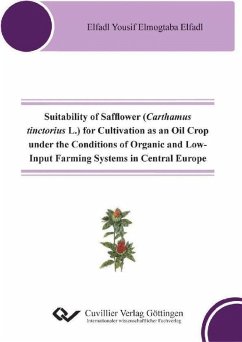An investigation was conducted to determine the extent of diversity and relationships
among a worldwide safflower (Carthamus tinctorius L.) germplasm collection and to find out
adapted accessions that can be used in an organic safflower breeding program in Germany. A
total of 468 accessions were studied under organic farming conditions at Kleinhohenheim
experimental station during the seasons of 2004 and 2005. All the accessions were evaluated
for 12 phenotypic traits and three rated diseases. Multivariate analyses have been used to
measure the diversity in a subset of 200 accessions and 11 geographical regions. Generally,
the study showed that there was a large genetic variation within accessions. A coefficient of
variation (CV %) for investigated traits and diseases ranged from 2.9 to 91.0% with the
highest CV was recorded for yield/m², yield/plant and seeds/plant. The most accessions that
originated in Europe revealed relatively better performance compared to non-Europeans. High
yielding, early maturing, and disease tolerant accessions were identified. However, the low oil
content (8.7-22.8%) is the primary concern in this germplasm collection. The degree of
heritability varied between 10% for lodging to 86% for plant height. Genotypic coefficient of
correlation (rg) was slightly higher for many traits than the respective phenotypic coefficient.
Oil content and seed yield/m² were highly significantly correlated (rg=0.78). The genotypic
coefficient of correlation showed that selection for seeds/plant and thousand kernel weight
was effective for improvement of seed yield and oil content. The results of the principal
component analysis and the clustering pattern of accessions were consistent with the results of
analysis of variance. About 78% of the total phenotypic diversity in the germplasm was
explained on the basis of four principal components and 88% of the total variation among
geographical regions was contributed by the first three principal components. The distribution
of the accessions within clusters has no apparent relationship with the geographical origin.
However, many of the European accessions have a tendency to stay together.
Dieser Download kann aus rechtlichen Gründen nur mit Rechnungsadresse in A, B, BG, CY, CZ, D, DK, EW, E, FIN, F, GR, HR, H, IRL, I, LT, L, LR, M, NL, PL, P, R, S, SLO, SK ausgeliefert werden.


